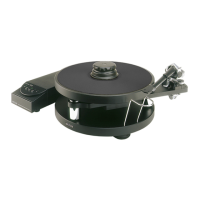upwards then forwards away from the front of the tone arm, the stylus guard affords
additional protection whilst doing this.
25. Operation (pick-up arm)
1. With the control lever in the raised position move the tone-arm out of the armrest and
position the arm so that the stylus is over the selected record groove.
2. To lower the stylus onto the record move the control lever forward until it is just past top
dead centre. This will set the lowering control in motion, at which point it will take over
the movement of the lever, giving a smooth controlled descent.
Note: For the correct descent time the control must be operated exactly as above. The
speed will be increased considerably if the lever is pushed down instead of being allowed
to fall of its own accord.
3. To raise the stylus from the record move the control lever back to its original position.
When the arm is not in use it should always be returned to the armrest for safety.
26. Maintenance (turntable)
1. There are no critical adjustments or need for ‘tweak’ and only very little maintenance.
Clean the drive belt occasionally by drawing it through a piece of soft linen moistened
with lighter fuel. The same material may be used to clean the periphery of the motor and
driven pulleys.
2. Having sintered bronze bearings the motor requires minimal lubrication. One drop of oil
only in one year is sufficient and must not be exceeded.
Remove the platter and drive belt. Apply one drop of 1287 lubricating oil from the
syringe at the point indicated on top of the motor. Choose a time when the turntable will
not be used for some hours so that the oil can find its way down to the lower bearing.
After this time check that there is no oil on the motor pulley and replace the drive belt and
platter.
3. Along with the motor the record spindle is a vitally important part of a good turntable and
for good performance must rotate with extremely small radial clearance. Sometimes
extremes of temperature can make this impracticable so the massive spindle of the Model
10 has a taper top-bearing which can be adjusted but only if it becomes absolutely
necessary. Check from time to time by removing platter and drive belt and spinning the
driven pulley. If it is stiff to turn and stops very quickly the bearing is too tight, if it
continues to spin for a very long time the bearing is too loose, somewhere between these
two conditions is correct.
Adjustment is carried out as follows:
Invert the base and sub-chassis assembly keeping the spindle clear of the table with some
judiciously placed books. At the centre of the base will be seen the bottom bearing cap
which is on a fine screw thread. Before leaving the factory this was scribed with a radial
line so that its adjustment can be positively identified, and we stress here that when

